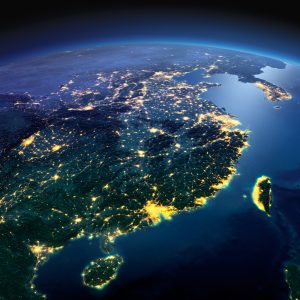Is a Chinese invasion of Taiwan tomorrow’s Ukraine war? The parallels between the two cases, where a revisionist power stands poised to pounce on a vulnerable neighbor, make it a scenario that is now feared by many. Sometimes, an invasion of Taiwan by China is even treated almost as a foregone conclusion, a question of “when” rather than “if.” Especially within military circles, predictions of a China-U.S. war over Taiwan in 2025 or 2027 have become common currency. At the same time, other commentators maintain that the risk of war remains low.
How can we adjudicate such claims? One answer is by looking at available forecasts. At the Swedish National China Centre, this is what we have done in a new report. For the first time, we have produced an overview of all available forecasts of a possible Taiwan conflict. We find that the results largely contradict the alarmist position. Forecasts consistently rate the risk of armed conflict in the Taiwan Strait as low.
Alarmist commentators overestimate the risk of war in at least three important ways.
First, it is often stated that China is arming itself specifically in preparation for a Taiwan invasion. 2027 often figures as a possible date for such an invasion, presumably because this year is an official milestone in the Chinese military’s modernization plans. But the year 2027 hardly figures at all in the scholarly forecasts we have examined.
Concerning China’s military modernization, forecasts do point to growing risk, but this is mainly a question of the gradually changing military balance vis-a-vis the United States in the region. A more even military balance inherently means growing risk, but that risk is growing from a very low baseline probability. It is still true that China cannot be confident to win a war with the U.S. over Taiwan, which keeps down the risk for the present.
Second, it is said that China cannot accept Taiwan’s democratic institutions, and that conflict can only be averted by the United States and other allies stepping up explicit support for Taiwan’s independence. But forecasts instead point to the worsening China-U.S. relationship itself as one of the major risk factors. Growing tensions over Taiwan are a consequence of increasing great power conflict. Beijing sees Taiwan as a part of the U.S. sphere of influence, and knows that an attack on Taiwan is a military attack on U.S. interests. If China-U.S. rivalry is kept within limits, China has little interest in provoking such a conflict.
Third, a common narrative among alarmists is the story of the changing Chinese regime. They warn us of China’s increasingly aggressive posture, its growing “assertiveness,” and an alleged ideological turn away from “openness” under the rule of Xi Jinping. By contrast, forecasters are divided on the question of whether China’s intentions concerning Taiwan have changed in any crucial regard. Xi Jinping hews close to the traditional Communist Party line of unquestioned sovereignty over Taiwan, and his international ambitions are likewise inherited from his predecessors. Most of China’s new-found “assertiveness” is likely less a matter of ideological change and more a matter of growing capabilities. From this, one might conclude that assumptions of extreme urgency on China’s part are faulty.
These are the takeaways from available forecasts, and they stand in stark contrast to alarmist predictions from the U.S. military and other actors. They suggest that alarmist narratives are arrived at by looking at the growing risk of war in isolation, without consideration of its general low baseline probability. Alarmists also tend to heavily exaggerate the degree of internal change caused by Xi Jinping, which is a factor that appears doubtful when aggregating forecasts.
Moreover, even though available forecasts rate the risk of war as low, they might still be overestimating it. This is because all these forecasts are found in works that study military issues and political attitudes. But other things matter, too. Taiwan’s crucial role in the semiconductor industry is well known, and destroying these supply chains would cost the world economy trillions of dollars per year. On top of this comes the effects of the economic warfare that almost certainly would result if China attacked Taiwan. Most estimates conclude that such consequences would hit China even harder than the West. It is hard to imagine that China does not realize this or refuses to take it into account when weighing the possibility of using force. This should further subtract from the generally low level of risk estimated by the forecasts we have reviewed.
All of this taken together suggests that a mix of military and economic deterrence, together with a responsibly managed China-U.S. relationship, can be expected to effectively prevent conflict even in the future. Most importantly, discussions of a possible Taiwan conflict should proceed from an understanding of the low baseline probability of such a scenario, not from panic-driven “when-rather-than-if” takes.

































